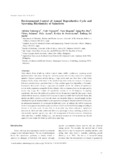Environmental control of annual reproductive cycle and spawning rhythmicity of spinefoots

ရှာဖွေ/ဖွင့်ပါ။
ရက်စွဲ
2015စာရေးသူ
Page views
631
Share
စိတ္တဇ
Many teleost fishes inhabiting shallow tropical waters exhibit synchronous spawning around species-selective lunar phases during their spawning season. For example, ovaries of the goldlined spinefoot (Siganus guttatus) develop during a single period each year from June to July in the Ryukyu Islands, Japan, while those of the goldlined spinefoot in the Karimunjawa Archipelago, Indonesia, develop twice a year from March to May, and then again from September to November. Increases in photoperiod and water temperature are possible cues for the initiation of reproductive activity in the populations around the Ryukyu Islands, while the transition between the rainy and dry season may trigger the initiation of reproductive activity in the Karimunjawa Archipelago populations. Moreover, the goldlined spinefoot releases its gametes around the first quarter moon period of the lunar phase, and since the lunar phase is consistent within the Indo-Pacific Ocean, this species can likely perceive cues from the moon and transcribe them as internal signals. In fact, periodical changes in moonlight intensity are expressed as changes in the plasma levels of melatonin, an endogenous transmitter of environmental light/dark cycles. In addition, the mRNA expression levels of clock genes of neural tissues [Cryptochrome (Cry3) and Period (Per2)] change according to changes in the lunar cycle. To date, how the lunar cycle may affect endogenous reproductive processes in fish is not fully understood. However, knowledge of lunar spawning periodicity in commercially important species may help in the management of fisheries resources, determining where and when to prohibit fishing (e.g., time and area closures), as well as promoting efficient aquaculture techniques for inducing synchronous spawning.
Suggested Citation
Takemura, A., Takeuchi, Y., Ikegami, T., Hur, S.-P., Soliman, V., Ayson, F., de Jesus-Ayson, E., & Susilo, E. S. (2015). Environmental control of annual reproductive cycle and spawning rhythmicity of spinefoots. Kuroshio Science , 9(1), 31-38. http://hdl.handle.net/10862/3063
ဘာသာရပ်
စုစည်းမှုများ စုစည်းမှုများ
- AQD Journal Articles [1249]
